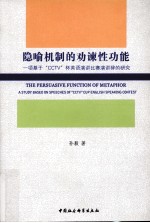

隐喻机制的劝谏性功能 一项基于“CCTV”杯英语演讲比赛演讲辞的研究PDF电子书下载
- 电子书积分:13 积分如何计算积分?
- 作 者:孙毅编著
- 出 版 社:北京:中国社会科学出版社
- 出版年份:2010
- ISBN:9787500483939
- 页数:369 页
List of Figures 22
Figure 2.1 The process of metaphoric mapping in cognitive metaphor theory 22
Figure 2.2 The 'four-space' mapping of conceptual integration theory 25
Figure 3.1 The general working mechanism of 'AntConc 3.2.0w(Windows)' 41
Figure 3.2 Procedure One of 'AntConc 3.2.0w(Windows)' in locating all usages concerned 42
Figure 3.3 Procedure Two of 'AntConc 3.2.0w(Windows)' in locating all usages concerned 43
Figure 3.4 Procedure Three of 'AntConc 3.2.0w(Windows)' in locating all usages concerned 43
Figure 4.1 All-inclusive distribution of conceptual metaphors in the corpora of "CCTV" Cup English Speaking Contest 161
Figure 5.1 The overall relationship between metaphorical persuasiveness and CDA 207
List of Tables 65
Table 4.1 Distribution of 'way metaphors' in journey metaphors 65
Table 4.2 Distribution of 'forward metaphors' in journey metaphors 68
Table 4.3 Distribution of 'build metaphors' in building metaphors 75
Table 4.4 Distribution of 'foundation metaphors' in building metaphors 77
Table 4.5 Distribution of 'fight metaphors' in conflict metaphors 81
Table 4.6 Distribution of 'for metaphors' in conflict metaphors 106
Table 4.7 Distribution of 'against metaphors' in conflict metaphors 109
Table 4.8 Distribution of light metaphors 116
Table 4.9 Distribution of 'harmony metaphors' in relationship metaphors 128
Table 4.10 Distribution of 'friend metaphors' in relationship metaphors 136
Table 4.11 Distribution of temporal metaphors 158
Lists of Concordancing Outcomes by'AntConc 3.2.0w(Windows)' 59
List 4.1 Concordancing outcomes of'way'by'AntConc3.2.0w(Windows)' 59
List 4.2 Concordancing outcomes of'forward'by'AntConc 3.2.0w(Windows)' 66
List 4.3 Concordancing outcomes of'build'and'building'by'AntConc 3.2.0w(Windows)' 71
List 4.4 Concordancing outcomes of'foundation'by'AntConc 3.2.0w(Windows)' 75
List 4.5 Concordancing outcomes of'fight'by'AntConc 3.2.0w(Windows)' 79
List 4.6 Concordancing outcomes of'for'by'AntConc 3.2.0w(Windows)' 82
List 4.7 Concordancing outcomes of'against'by'AntConc 3.2.0w(Windows)' 107
List 4.8 Concordancing outcomes of'light'by'AntConc 3.2.0w(Windows)' 112
List 4.9 Concordancing outcomes of'harmony'and'harmonious'by'AntConc 3.2.0w(Windows)' 118
List 4.10 Concordancing outcomes of'friend'and'friends'by'AntConc 3.2.0w(Windows)' 128
List 4.11 Concordancing outcomes of 'past' by 'AntConc 3.2.0w(Windows)' 140
List 4.12 Concordancing outcomes of 'now' by 'AntConc 3.2.0w(Windows)' 144
List 4.13 Concordancing outcomes of 'future' by 'AntConc 3.2.0w(Windows)' 153
Chapter One Introduction 1
1.1 The significance of studying metaphor in public speaking 1
1.2 Objectives of the present study 4
1.3 Outline of the dissertation 5
Chapter Two Review of Related Literature 7
2.1 Various previous approaches towards metaphor 7
2.1.1 The Aristotelian approach 8
2.1.2 The Vico view 9
2.1.3 Semantic approaches 10
2.1.4 Generative approaches 13
2.1.5 Pragmatic approaches 14
2.1.6 Conceptualist approach 21
2.2 The necessity of incorporating Critical Discourse Analysis in researching metaphor 27
2.2.1 Essentials of Critical Discourse Analysis 27
2.2.2 Reconciliation of CDA and cognitive metaphor research 32
2.3 Summary 36
Chapter Three Methodology in Identifying and Deciphering Metaphors:The Hybridization of Quantitative and Qualitative Analyses 37
3.1 Quantitative analysis 38
3.1.1 Imperfections of cognitive metaphor theory in identifying metaphors 38
3.1.2 Values of corpus-based research 39
3.1.3 Corpus-based description in the dissertation 39
3.2 Qualitative analysis 46
3.3 Metaphor deciphering in CDA 49
3.3.1 Metaphor description 50
3.3.2 Metaphor interpretation 51
3.3.3 Metaphor explanation 52
3.4 Summary 53
Chapter Four Distribution and Elucidation of Conceptual Metaphors in "CCTV" Cup English Speaking Contest 55
4.1 The gist of the art of public speaking 55
4.2 Distribution and elucidation of conceptual metaphors in public speaking corpus 58
4.2.1 Journey metaphors 58
4.2.2 Building metaphors 70
4.2.3 Conflict metaphors 79
4.2.4 Light metaphors 110
4.2.5 Relationship metaphors 117
4.2.6 Temporal metaphors 137
4.3 Summary 160
Chapter Five Persuasive Function of Metaphor in Public Speaking 163
5.1 Metaphor and persuasion in public speaking 165
5.2 Metaphor and intentions 171
5.3 Metaphor and emotions 179
5.4 Metaphor and evaluation 188
5.5 Metaphor and analogical reasoning 196
5.6 Summary 205
Chapter Six Conclusion 209
6.1 A brief summary of the study 209
6.2 Implications:using metaphor for pedagogical purposes 212
6.2.1 Enhancing learners' awareness towards metaphor 213
6.2.2 Metaphor and speaking 216
6.2.3 Metaphor and writing 220
6.3 Problems and limitations of this research 226
6.4 Suggestions for further studies 227
Appendices:Corpora of Speeches of the Fifth "CCTV" Cup English Speaking Contest 229
Bibliography 354
- 《TED说话的力量 世界优秀演讲者的口才秘诀》(坦桑)阿卡什·P.卡里亚著 2019
- 《演讲与口才》达夫编著 2018
- 《科普演讲就该这么讲》(中国)《科普演讲就该这么讲》编委会 2019
- 《齐心开创共建“一带一路”美好未来 在第二届“一带一路”国际合作高峰论坛开幕式上的主旨演讲》习近平著 2019
- 《功能涂料》刘仁主编 2018
- 《演讲与提升系列 说话的艺术 轻松应对生活中的社交难题》刘楠 2019
- 《海洋功能食品》王卉 2019
- 《人人都是演讲家》李易真著 2018
- 《功能食品 第2版》孟宪军 2017
- 《汉语韵律的多维特征及其认知功能》吴洁敏,朱宏达著 2019
- 《市政工程基础》杨岚编著 2009
- 《家畜百宝 猪、牛、羊、鸡的综合利用》山西省商业厅组织技术处编著 1959
- 《《道德经》200句》崇贤书院编著 2018
- 《高级英语阅读与听说教程》刘秀梅编著 2019
- 《计算机网络与通信基础》谢雨飞,田启川编著 2019
- 《看图自学吉他弹唱教程》陈飞编著 2019
- 《法语词汇认知联想记忆法》刘莲编著 2020
- 《培智学校义务教育实验教科书教师教学用书 生活适应 二年级 上》人民教育出版社,课程教材研究所,特殊教育课程教材研究中心编著 2019
- 《国家社科基金项目申报规范 技巧与案例 第3版 2020》文传浩,夏宇编著 2019
- 《流体力学》张扬军,彭杰,诸葛伟林编著 2019
- 《红色旅游的社会效应研究》吴春焕著 2019
- 《中国当代乡土小说文库 本乡本土》(中国)刘玉堂 2019
- 《社会学与人类生活 社会问题解析 第11版》(美)James M. Henslin(詹姆斯·M. 汉斯林) 2019
- 《异质性条件下技术创新最优市场结构研究 以中国高技术产业为例》千慧雄 2019
- 《中国铁路人 第三届现实主义网络文学征文大赛一等奖》恒传录著 2019
- 《莼江曲谱 2 中国昆曲博物馆藏稀见昆剧手抄曲谱汇编之一》郭腊梅主编;孙伊婷副主编;孙文明,孙伊婷编委;中国昆曲博物馆编 2018
- 《中国制造业绿色供应链发展研究报告》中国电子信息产业发展研究院 2019
- 《中国陈设艺术史》赵囡囡著 2019
- 《指向核心素养 北京十一学校名师教学设计 英语 七年级 上 配人教版》周志英总主编 2019
- 《《走近科学》精选丛书 中国UFO悬案调查》郭之文 2019
